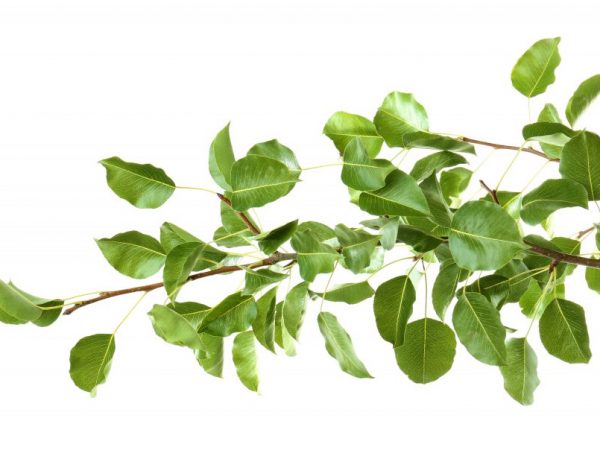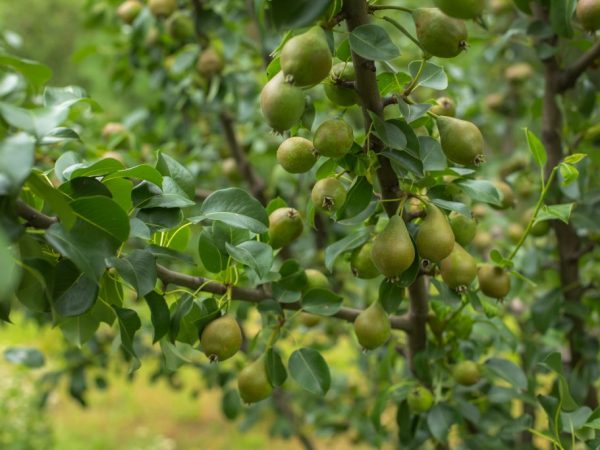Characteristics of the variety of pears Children's
Among summer varieties with stable fruiting, Children's pear is especially popular. It was bred by a breeding institute in Moscow as a result of crossing the summer Duchesse and hybrid No. 8.

Characteristics of the variety of pears Children's
Characteristics of the variety
A frost-resistant summer variety that is suitable for growing in different climatic conditions. Does not require complex agrotechnical techniques to obtain a high-quality harvest.
One of the few ultra-early varieties that ripens after July 15th. Fruiting is long, pears can be harvested for 1.5 months. Productivity is high, 30-35 kg ripens on one adult tree. The fruiting period begins 3-5 years after planting. Pear Children's longevity and preservation of the yield level for more than 25 years. It can grow in isolation, does not require pollinators, but it can serve as a quality pollinator for summer varieties (Melting, Ilyinka, Cathedral).
The variety is resistant to pests and diseases. Also, the Children's pear easily tolerates subzero temperatures in the winter, does not freeze. Spring frosts for this variety also do not pose a threat. The variety is resistant to long periods of drought. These qualities make the variety versatile for cultivation both in the south and in the northern regions.
Description of the tree
Children's Pear is a fruit tree with a crown shaped like a pyramid. She grows over 5 m in height. The branches are well developed, with many branches in which the fruits are tied. The annual growth of branches is 40-50 cm. The leaves are oval, medium-sized, dark green, their inner side is green-blue, the foliage is medium. The bush begins to bloom in early May.
Description of fruits
The fruits grow in a beautiful uniform shape weighing 85-90 g. The surface is uneven, slightly lumpy. The main color of the fruit is yellow; during ripening, the side turns orange-pink. The pulp is juicy, homogeneous, creamy. The fruit has a sweet taste. They are removed by the fruits as they ripen, preventing overripening. It can be stored in the refrigerator for 30-35 days without losing its taste. They are ideal not only for fresh consumption, but also for preservation, compotes, jams.
Advantages and disadvantages
Children's pear variety has both advantages and disadvantages.
Among the advantages are:
- early maturity;
- stable yield;
- frost resistance and winter hardiness;
- resistance to fungal diseases;
- versatility of use;
- self-pollination.
There are few disadvantages of the variety, among them medium-sized fruits and the need for crown formation are noted.
Planting seedlings

Seedlings are planted in autumn
Saplings are planted in autumn or early spring. Agronomists advise planting fruit trees in autumn, in September-October. If you plant a pear during this period, it will have enough time to take root, all energy will be focused on this process.In spring, trees can also be planted, this is done immediately after the soil freezes until the buds open. In the spring, the process of root formation is slowed down, because in parallel the tree will dissolve buds, grow young branches and leaves.
Choosing a landing site
An important role is played by the choice of a place for planting pears. The pear tree grows well in drained soils with low-lying groundwater (at a depth of 2.5-3 m). Pears do not tolerate waterlogged soils poorly, root poorly, weak roots are formed, are often affected by fungal diseases, and can rot. A healthy, well-developed root system is the foundation for the full development of the entire plant.
It is better to choose a place for planting that is well-lit, without strong shading, on the south side of the personal plot. Protection from northerly winds also has a beneficial effect on the cultivation of pears in the garden.
Sapling selection
In order for a seedling to take root easily and grow into a well-developed, consistently fruitful tree, it must be healthy. When choosing a seedling in a nursery, garden center or at an exhibition, you need to pay attention to the following characteristics:
- age;
- the state of the root system;
- the general condition of the seedling;
- scion quality;
- condition of the vaccination site.
The optimal age of seedlings for planting Detskaya pears is 1-2 years. Young seedlings take root more easily and grow faster. An annual seedling has one central stem, lateral branches are not developed. The two-year-old has branches of the second order. It is very important to carefully examine the root system: it must be well developed, not mechanically damaged, without mold and rot. The seedling should look healthy, without growths, spots, damage.
Graft
For nursery pear seedlings, use a graft of quince or wild seed pear. The time of the pear's entry into fruiting and the height of the tree depend on the scion. Those grafted on quince begin to bear fruit earlier, 3 years after planting, grow up to 5 m. On a pear scion, the first fruits are tied 5 years after planting, and the tree grows more than 5 m. The grafting site should be well spliced, without unnatural growths.
Planting pit preparation and planting
Having chosen a good seedling and a place for planting, you need to prepare a hole for planting. In order for the pear to quickly take root and plant success, you need:
- dig a hole measuring 1 x 1 x 0.7 m;
- mix soil with compost, low-lying peat and river sand;
- loosen the bottom of the planting pit and pour a pile of prepared soil;
- pour water on one hole 1-2 buckets of water.
- install the support in the center of the pit.
Before planting, the root of the seedling is kept in warm water for 6-12 hours. After such a procedure, the plant is planted in a prepared hole, gradually sprinkled with earth, make sure that the roots lie flat and do not bend, and the root collar is at a level of 2-4 cm above the surface. After filling the hole completely, the periosteal circle is slightly compacted, the trunk is attached to the support, and also mulched with peat or compost 4-5 cm thick. After a week, the seedling is poured with a bucket of water and ground is added in case of shrinkage. When frosts come, the trunk is wrapped with spruce branches or agrofibre: this protects against rodents and severe frosts.
Care

Good care increases the yield of the tree
The quality of the fruit, yield and stress resistance of Detskaya pears depends on the quality of care. In the first years after planting, a thorough approach to agricultural technology is important. In order for the tree to develop intensively, it began to bear fruit at the time indicated in the description, and a lot of fruits ripened, you need the soil regularly:
- watering;
- loosen;
- mulch;
- feed.
Watering
The pear is a crop that grows poorly in waterlogged soils and can withstand short-term droughts. But in the first years after planting, regular watering must be carried out, this is due to the fact that the root system is still not strong enough, and during periods of drought it will not be able to fully provide the plant with moisture.The pear is watered during the period of high temperatures and the absence of rain 1-2 times a week, 10-12 liters of water are poured under one tree. Adult fruiting trees are watered at the beginning of flowering until the formation of a mass ovary.
Loosening
The soil is loosened in the near-trunk circle once every 2-3 weeks to a depth of 15-20 cm. Loosening is carried out after watering or rain. This procedure enriches the topsoil, which will have a good effect on the nutrition process, and also prevents the development of fungal diseases, improving gas exchange.
Mulching
In early spring and late autumn, mulching the soil around the tree is carried out. Peat, compost, straw, rotted dry manure mixed with soil are used as mulch. Mulch is laid out with a thickness of 2-3 cm: it protects against spring frosts, extremely low temperatures in winter, warming the soil, improves the structure of the soil and serves as a tree feed. Before mulching, the peri-stem circle is well watered and loosened.
Top dressing
Top dressing is carried out 2-3 times per season. Young seedlings are fed in spring and autumn with nitrogen fertilizers (urea, manure, chicken droppings).
To fertilize with manure or chicken droppings, a slurry is prepared. 1 tbsp. manure is added to a bucket of water, mixed and infused for 5 days. Before use, 1 liter of slurry is diluted in a bucket of water. Water the near-stem circle: for one seedling, 2-3 liters of top dressing is enough. When the pears begin to bear fruit, the feeding scheme is changed and fertilized three times per season:
- In early spring, after freezing of the soil. Complex fertilizers are used for fruit or urea with superphosphate (10 g of urea and 10 g of superphosphate are added per 1 sq. M), fertilizers are embedded in the ground and watered with water.
- At the beginning of flowering. Feeding is carried out with potash fertilizers, it can be kalimag (10 g / sq. M) or ash at the rate of 1 tbsp. for 1 tree.
- After harvest. Phosphate fertilizers are used. Superphosphate (10 g / sq. M), bone meal, ash are suitable.
Pruning
Children's pear is a variety that requires shaping and pruning. It begins after planting the seedling for this, the top of the central trunk is cut off at the level where the tree will begin to form a crown. Gardeners practice this at a height of 1.3-1.5 m. A cut is made over a developed bud with a sharp pruner, then covered with garden pitch.
The next pruning is carried out in the spring before the onset of sap flow and swelling of the buds. By pruning, branches of 2, 3 and subsequent levels are gradually formed.
Pruning of mature pear trees is carried out every spring. Correct the shape of the crown, cut out old and dried branches, and also clean out the branches that grow inward and thicken the crown. All sections are carefully covered with garden var.
With the help of pruning, you can not only form a beautiful tree, but also protect it from the development of fungal diseases that occur when the crown thickens and poor ventilation.
Conclusion
As the description shows, the Children's pear tree is suitable for growing on individual household plots, especially those where it is not possible to plant more than one pear tree. This variety ripens quickly, has small, but very tasty and sweet fruits.


